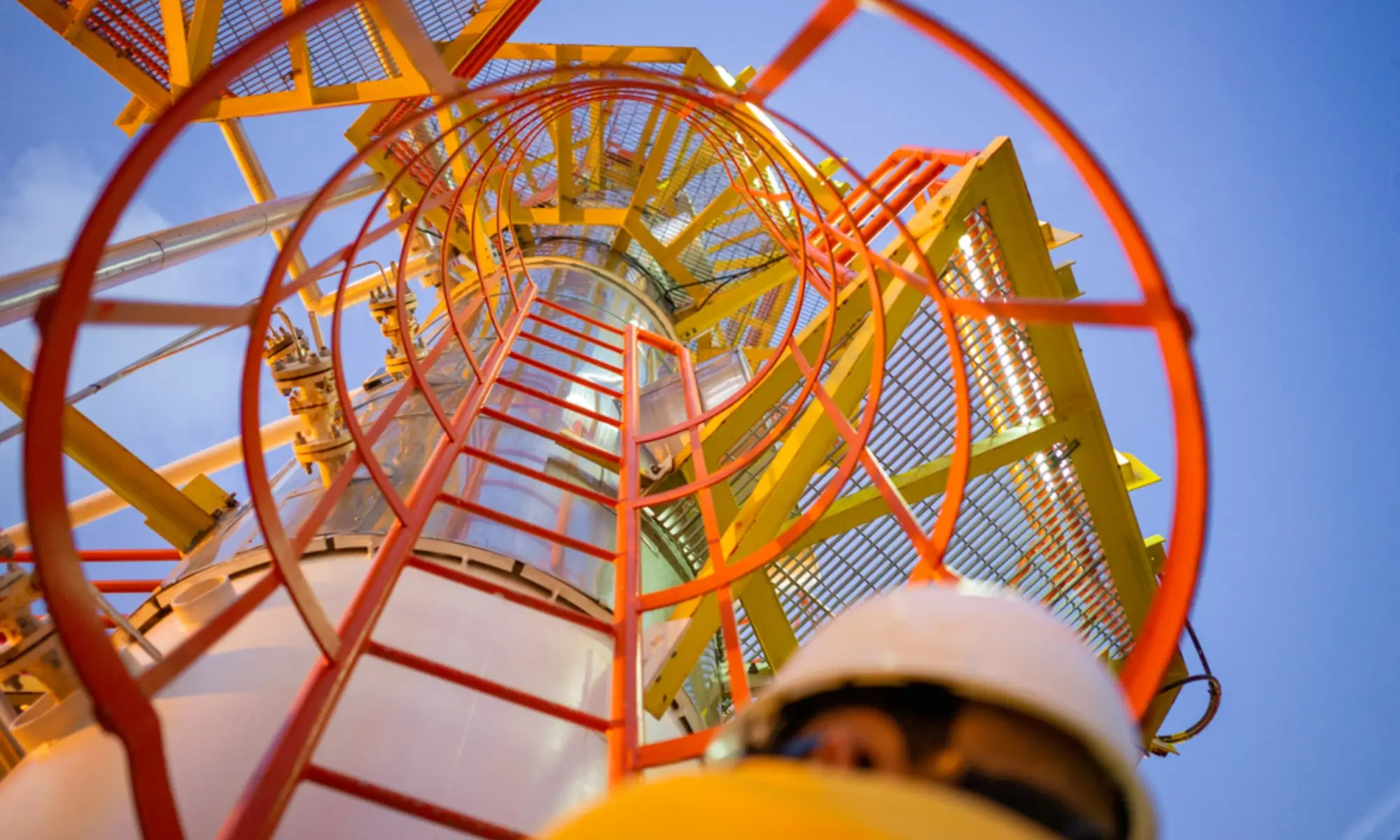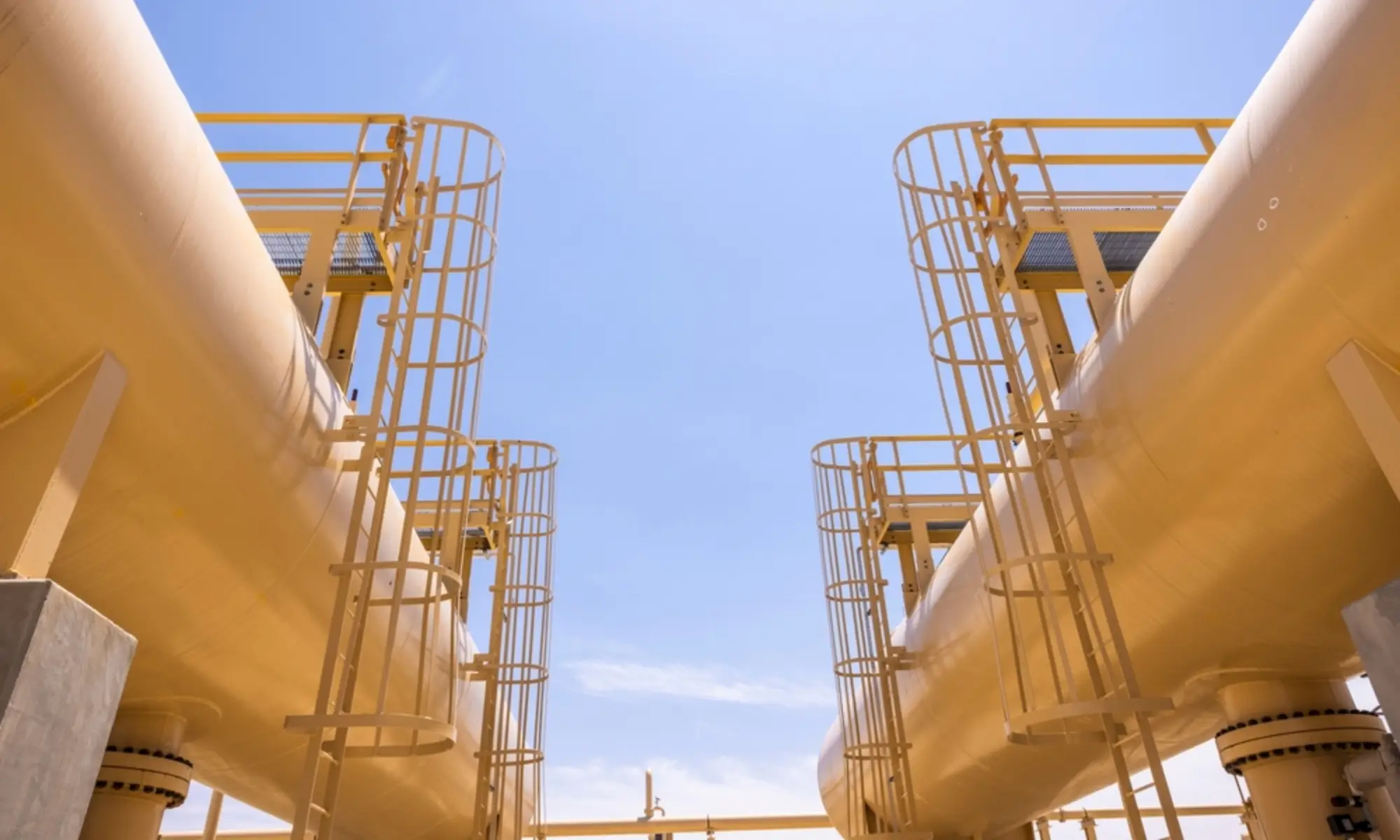Ladder cages are an integral part of safety systems on fixed ladders, designed to provide a protective barrier for workers climbing at height. While once considered a standard form of fall protection, ladder cages are now considered supplementary, with new OSHA regulations favoring more effective fall arrest systems.
This blog explores the purpose, functionality, and benefits of ladder cages and best practices for safe usage. Additionally, we discuss whether ladder cages effectively prevent falls, highlight alternatives for enhanced safety, and review current OSHA standards to help employers create a safer work environment for their teams.

What is a Ladder Cage?
A ladder cage is a protective enclosure attached to the sides of fixed ladders, typically those extending more than 20 feet above the ground. Constructed with metal hoops and vertical bars, the cage surrounds the climbing area, creating a tunnel-like structure that provides a physical barrier around the workers as they climb or descend. Ladder cages are commonly seen on the exteriors of industrial buildings, warehouses, and silos.
Purpose and Functionality of Ladder Cages
Originally, ladder cages were designed to offer additional safety by enclosing the climber and reducing the risk of falls. The idea was that, in case of a slip or loss of balance, the cage would help prevent the worker from falling sideways or backward. While they can serve as a psychological safety boost for some climbers, the effectiveness of ladder cages as a reliable fall protection system has come under scrutiny in recent years.
Benefits of Ladder Cages
- Fall Protection: They provide some support by preventing climbers from falling sideways or backward.
- Improved Balance: The cage structure can offer a sense of stability, giving climbers a way to brace themselves in case of minor slips.
- Regulatory Compliance (Until Recently): For many years, ladder cages were a standard requirement under U.S. and international safety regulations.

Tips for Safe Usage of Ladder Cages
While ladder cages may no longer be the recommended safety measure, many workplaces still have them installed on existing ladders. Here are some essential tips for using them safely:
1. Conduct Regular Inspections
Ladder cages require periodic inspections to ensure they are structurally sound and safe to use. Check for:
- Structural Integrity: Look for any rust, corrosion, or loose bolts in both the ladder and the cage. Weak or damaged parts can compromise safety.
- Obstructions: Make sure no objects or debris inside the cage could obstruct movement. Anything blocking the cage or ladder could hinder a climber’s ability to use it safely.
2. Ensure Proper Clearance
Adequate clearance inside the cage allows workers to climb comfortably without feeling cramped. For safety:
- Verify Cage Dimensions: Confirm that the cage meets clearance standards, allowing sufficient space for a person to ascend and descend safely.
- Check for Headroom and Foot Clearance: Avoid anything that could restrict headroom or cause a climber to trip. Proper clearance prevents potential entrapment and allows climbers to adjust their position as they climb.
3. Provide Worker Training
Workers should be trained on ladder cage usage, including understanding the limitations and safe practices for climbing with cages. Training should cover:
- Proper Climbing Techniques: Emphasize the “three points of contact” rule—always keep two hands and one foot, or two feet and one hand, in contact with the ladder.
- Cage Limitations: Educate workers on how ladder cages do not fully prevent falls and should not be leaned against for support. Training on cage limitations reduces risky behaviors that might lead to accidents.
4. Supplement with a Fall Arrest System
Add a fall arrest system (such as a vertical lifeline or self-retracting lifeline) alongside the ladder cage to enhance safety, especially on ladders taller than 24 feet. This provides:
- Backup Safety: In the event of a fall, these systems quickly arrest the worker’s descent, minimizing injury risk.
- Enhanced Compliance: As OSHA phases out cages as a primary fall protection method, having a fall arrest system helps meet current and future safety standards.
5. Establish a Rescue Plan
Rescue planning is essential when using ladder cages because extraction can be challenging if a worker falls and becomes trapped. Key elements include:
- Clear Procedures: Outline step-by-step actions to safely remove a worker from a ladder cage.
- Rescue Equipment: Ensure that rescue equipment is readily accessible and workers are trained to use it.
- Practice Drills: Regularly practice rescue procedures to ensure responders are prepared to act quickly and safely.
These tips help maximize the safety of ladder cages and address their limitations. Regular maintenance, comprehensive training, and the supplementation of additional safety systems will help create a safer environment for workers.

Are Ladder Cages Effective for Fall Protection?
Ladder cages, once standard for fall protection on fixed ladders, have been found to offer limited effectiveness in preventing falls. Here’s a closer look at why they may not provide adequate fall protection:
1. Limited Fall Arrest Capabilities
Ladder cages were initially designed to reduce the risk of a worker falling sideways or backward off the ladder. However, they do not prevent a downward fall:
- Minimal Arrest Support: While the cage may keep a climber closer to the ladder, it does not effectively stop a fall. If workers lose their footing, they may slide down the ladder within the cage, potentially leading to serious injury.
- Not Designed for Full Protection: Cages do not offer the same level of support as a fall arrest system. They cannot “catch” a worker the way a vertical lifeline or self-retracting lifeline can, which limits their reliability in preventing significant falls.
2. Potential for Increased Injury in a Fall
Ironically, in some cases, ladder cages can contribute to injury rather than prevent it:
- Risk of Head or Body Impact: During a fall, the climber may strike their head or limbs against the cage’s metal bars, leading to serious injuries.
- Difficulty in Rescue Situations: In the event of a fall, extracting a worker from a cage can be challenging for rescuers, especially if the worker is unconscious. Rescue procedures become more complicated when a person is trapped within the cage structure.
3. Psychological vs. Practical Safety
Ladder cages often provide a sense of psychological security but may not deliver the actual safety needed in a fall:
- False Sense of Security: Workers may feel more secure in a caged ladder, which could lead to overconfidence in their safety. This belief can sometimes result in riskier behaviors, like leaning against the cage for support, which may lead to accidents.
- Limited Use in Preventing Real Falls: Studies and workplace data show that cages only offer limited protection, as they are not designed to actually “arrest” a fall. They only help prevent falling away from the ladder but do not stop a person from descending rapidly.
4. Regulatory Shifts Reflect Limited Effectiveness
Due to these limitations, regulatory bodies such as OSHA have updated standards, phasing out cages as a compliant form of fall protection:
- OSHA’s New Standards: OSHA no longer allows cages as an acceptable fall protection measure for new ladders installed after 2018. By 2036, all ladders taller than 24 feet must have a personal fall arrest system or ladder safety system.
- Emphasis on Fall Arrest Systems: To better protect workers at heights, OSHA’s updated guidelines focus on systems that reliably arrest falls, such as vertical lifelines or self-retracting lifelines.
While ladder cages may provide some lateral protection and psychological comfort, they are not dependable fall protection solutions. Cages can prevent a worker from falling sideways or backward, but they are ineffective at stopping a downward fall. Modern fall arrest systems, such as vertical lifelines, offer a safer, more reliable solution for preventing falls from ladders, and OSHA’s updated regulations reflect this shift.
Ultimately, employers and safety officers should consider upgrading to ladder safety systems that meet current standards to ensure comprehensive fall protection for workers.

Alternatives to Ladder Cages for Enhanced Safety
As ladder cages are phased out as a compliant safety measure, several alternative systems offer more reliable fall protection. These alternatives provide enhanced safety, especially for ladders that extend over 24 feet and are designed to arrest falls quickly and effectively, reducing the risk of injury. Here are some of the most effective alternatives:
1. Vertical Lifeline Systems
A vertical lifeline is a safety system that runs alongside the ladder and allows workers to connect using a harness and shuttle device. In the event of a fall, the system locks to arrest the descent.
Key Benefits:
- Continuous Protection: Provides consistent fall protection throughout the entire climb.
- Automatic Arrest: The shuttle device grips the lifeline automatically in case of a fall, preventing the worker from descending.
- Compliance with OSHA Standards: Meets OSHA requirements for ladders installed after 2018, providing full compliance for new ladder installations.
Vertical lifelines are often used on fixed ladders in industries such as telecommunications, energy, and construction, where height access is frequent.
2. Self-Retracting Lifelines (SRLs)
Self-retracting lifelines (SRLs) are mounted at the top of the ladder or structure and extend a retractable line connected to the worker’s harness. If a fall occurs, the line locks immediately to stop the descent.
Key Benefits:
- Minimal Fall Distance: SRLs arrest a fall within inches, significantly reducing impact and injury risk.
- Freedom of Movement: The retractable line allows workers to move freely while climbing, providing safety without hindering mobility.
- Durability: SRLs are built for outdoor and industrial environments, making them a long-lasting solution.
SRLs are ideal for locations where ladders are exposed to the elements and where workers require a full range of movement.
3. Fixed Track Ladder Safety Systems
Fixed track systems are another alternative to traditional lifelines. These consist of a rigid track installed alongside the ladder, with a mobile shuttle device that connects to the worker’s harness.
Key Benefits:
- Reduced Swing Fall: Unlike flexible cables, the rigid track keeps the worker close to the ladder, minimizing swing in case of a fall.
- Ease of Use: Track systems allow smooth movement, so workers can easily climb or descend without feeling the system drag.
- Multi-Worker Access: Some rigid track systems allow multiple workers to use the same track, which is especially useful in larger work environments.
Fixed track systems are popular for tall structures like radio towers, silos, and industrial machinery where reducing swing fall is a priority.
4. Guardrails and Intermediate Platforms
For environments with frequent ladder access needs, guardrails, and intermediate platforms can reduce risk by providing rest points and safer ladder transitions.
Key Benefits:
- Reduced Climb Height: Intermediate platforms allow workers to break up long climbs, reducing fatigue.
- Increased Stability: Guardrails at each landing offer additional safety and a place to stabilize when transitioning.
- Lower Risk of Fatigue-Related Falls: Workers are less likely to experience fatigue-induced accidents by breaking the climb into sections.
Guardrails and platforms are commonly used in industries with high ladder traffic, such as warehouses, refineries, and high-rise building maintenance.
5. Personal Fall Arrest Systems
Personal fall arrest systems include harnesses, connectors, and anchor points designed to catch a worker in the event of a fall. While typically used for open, elevated work, they can be adapted for ladder use with the addition of appropriate anchorage.
Key Benefits:
- Customizable Safety: Different configurations allow for the system to be tailored to specific worksite needs.
- Portable Solution: Workers can carry personal fall arrest equipment with them, providing flexibility across different ladder installations.
- OSHA-Compliant: Personal fall arrest systems meet OSHA’s updated standards for fall protection.
These systems are useful when fixed ladders do not have dedicated safety systems or temporary ladder installations are used.
While ladder cages may still exist on older ladders, modern safety alternatives provide much more reliable fall protection. From vertical lifelines and SRLs to fixed track systems and intermediate platforms, several effective options reduce risks and meet updated OSHA requirements. By adopting these enhanced safety solutions, employers can provide a safer work environment, minimize liability, and comply with evolving safety regulations.

OSHA and Regulatory Standards for Ladder Cages
The Occupational Safety and Health Administration (OSHA) has updated its regulations on ladder safety, recognizing that cages alone may not provide adequate fall protection.
Key OSHA Updates:
- Existing Ladders Installed Before November 19, 2018: These ladders may still include cages or wells, but they must also be equipped with a personal fall arrest or ladder safety system by November 18, 2036.
- New Ladders Installed On or After November 19, 2018: OSHA mandates that all newly installed ladders exceeding 24 feet in height must use a ladder safety system or personal fall arrest system instead of cages.
- Complete Phase-Out by 2036: After November 18, 2036, ladder cages will no longer be accepted as a compliant form of fall protection for fixed ladders taller than 24 feet.
These changes reflect evolving research and a better understanding of safety risks associated with ladder cages.
Conclusion
In conclusion, while ladder cages have historically served as a primary safety feature on fixed ladders, advancements in fall protection standards and OSHA regulations have highlighted their limitations. Ladder cages may offer some lateral support and psychological comfort, but they lack reliable fall arrest capabilities for modern safety systems.
Employers should consider implementing alternative solutions such as vertical lifeline systems, self-retracting lifelines, or fixed track systems to enhance worker safety and meet regulatory requirements. By adopting these improved safety measures, organizations can ensure better employee protection, minimize the risk of accidents, and maintain compliance with evolving safety standards.

